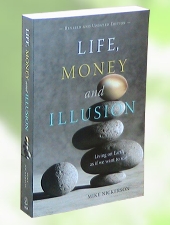The whole story:

Life, Money
and Illusion
Things are what they are first, and
what we call them second
Some thoughts that emerged from a recent Faith and Science discussion about how perception of things evolves as science investigates.
We discussed how each new discovery expands our knowledge. Many advances reveal new areas to explore for still deeper understanding. The bits of information gathered make up a picture and names are given to the various parts so that the understanding can be shared.
This step-by-step expansion of understanding brought to mind an analogy with digital music recording. With a hundred bits of tonal information recorded for each second of music, a certain quality is achieved. One might consider this the level at which we understand what the musicians are producing. If the recording is done with a thousand bits of information each second, the tune is clearer, the approximation of the original more closely aligned. The essential music is better received (understood).
The fidelity of digital recording has increased to a remarkable point. That said, it is still digital. It represents the music, but it is not the music. As with digital printing, it remains “stair-stepped” regardless of how fine the increments are.
Analogue recording uses a different technique. It doesn’t need to establish data-points for each instant of the sound. An analogue recording simply sways with the variations of the tune, following the ups and downs faithfully as they occur. There are no “stair steps”.
That said, analogue recording has limitations. While the sounds and meter impress the recording device as they flow, there are elements of musical expression that can be sensed when listening to live music, for which there are no recording techniques. Soul perhaps. Indeed, there are likely dimensions of many things which we study about which we have no awareness.
Light is like particles. Light is like waves. These analogies enable us to work with light, but they don’t actually reveal what light is. Light exists independent of our understanding.
Actual live music, like the reality of a phenomenon being studied, exists independently of any names or recorded detail. When encountering a phenomenon, one can simply grok it. To grok is to perceive with all one’s senses, without internal comment, identifying names or studied details. If one is up on the science of the phenomenon, it may embellish the sense received, but when the names of parts come to mind, the presence of the actual thing is obscured.
The discoveries of science enable useful tools for working with our world, but the named details can also inhibit our direct perception of what we find around us. Hence the notion that things are what they are first and what we call them second. One might add that what we call things is ultimately irrelevant to their existence.
A rose, by any other name would smell as sweet. Yet one has to slow down and smell the roses to realize this.
Some time after drafting this idea, it occurred to me that the same issue exists with the more fun, less stuff / more joy, less stuff project. If you haven’t received the details of that discussion about joy, fun, life, love and the like, I can send the summary. In this context, we have been looking for a word that represents the spectrum of life-based activity so we can make the point in the fewest possible words that living has a huge amount to offer that doesn’t require over exploiting natural resources or other people.
Words are almost essential to communicate ideas and information, but as this piece describes, the words are not the things they refer to. With “More Joy, Less Stuff” we aim to communicate a fundamental shift in the goals of society. Would that there were a way to share the gestalt directly. Alas, until the “bandwidth” of direct personal communication can be reproduced in quantity, we depend on words.
![]()
